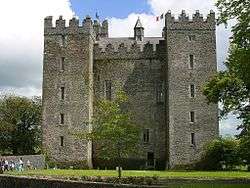Dunasead Castle

Dunasead Castle (Dún na Séad in Irish, meaning Fort of the Jewels), sometimes known as Baltimore Castle is a 17th-century fortified house situated in the town of Baltimore in western County Cork, Ireland.[1]
History
The present castle is not the first to have been built on the site.[2] In 1215, an Anglo-Norman settler, FitzStephens, built a tower house with a bawn there, which itself replaced a much older fortification, probably a ringfort. In 1305, the castle was attacked and burned down by one of the most powerful Gaelic septs in the region, the MacCarthys. Another Gaelic sept, the O'Driscolls, much smaller but still powerful in the region, subsequently took possession of Dunasead and rebuilt it.
The O'Driscolls were constantly under pressure from encroachments by Anglo-Norman settlers and rival Gaelic clans on their territory and trade interests, which resulted in the castle being attacked and destroyed numerous times in the following centuries. One especially long-running feud erupted between the O'Driscolls and the merchants of Waterford City in 1368, following an attack on the Waterford fleet by the O'Driscolls. This feud continued on and off for almost two centuries, ending in the sacking of Dunasead, Baltimore and other O'Driscoll castles by another Waterford fleet in 1537.
The castle was rebuilt, but, following the O'Driscolls' support for Hugh O'Neill at the Battle of Kinsale, the castle was surrendered to the English army. Some of the O'Driscolls received pardons, and Dunasead was returned to Florence O'Driscoll, who subsequently leased it out, along with most of his lands, due to financial problems. The present castle was probably built in the 1620s and was surrendered to Oliver Cromwell's forces in the 1640s.[3]
The castle later fell into ruins, but was renovated between 1997 and 2005 and is now in use as a private residence.[4][5]
Architecture
Dunasead is built on a ridge of sandstone in the heart of Baltimore, overlooking the harbour. It consists of a two-storey rectangular building (with an additional attic space) surrounded by a bawn or curtain wall. The main building is set into the south-west wall of the bawn, and measures approximately 6 by 18 metres (20 by 59 ft). This building's defensive features are rather meagre compared to those of the earlier tower houses in the region; on the ground floor, the windows are narrow slits, and there is a bartizan on the south-west corner. Only the bawn could have provided any protection in the event of an attack.
Further reading
- Carroll, M.J., 2001. The Castles and Fortresses of West Cork. Published by Bantry Studio Publications, Bantry, County Cork.
References
- ↑ "Extract of report on excavation at Dunnasead Castle, Baltmore (1998)". Excavations.ie - Database of Irish Excavations. Archived from the original on 17 July 2011.
- ↑ Eoghan Kieran & Julianna O Donoghue (May 2013). Marine Cultural Heritage Assessment and Visual Impact Assessment of Proposed Pier Road Widening at Baltimore, Co Cork (PDF) (Report). Cronin Millar Consulting Engineers. Retrieved 29 October 2016.
- ↑ "History of Dún na Séad Castle". Baltimore Heritage Limited. Retrieved 29 October 2016.
- ↑ "Baltimore Castle , Baltimore, West Cork, Ireland". Baltimorecastle.ie. Retrieved 29 October 2016.
In 1997 the extensive task of restoration began
- ↑ "Dun na Sead Castle". DiscoveringIreland.com. Retrieved 29 October 2016.
See also
Coordinates: 51°29′01″N 9°22′23″W / 51.4835°N 9.373°W
